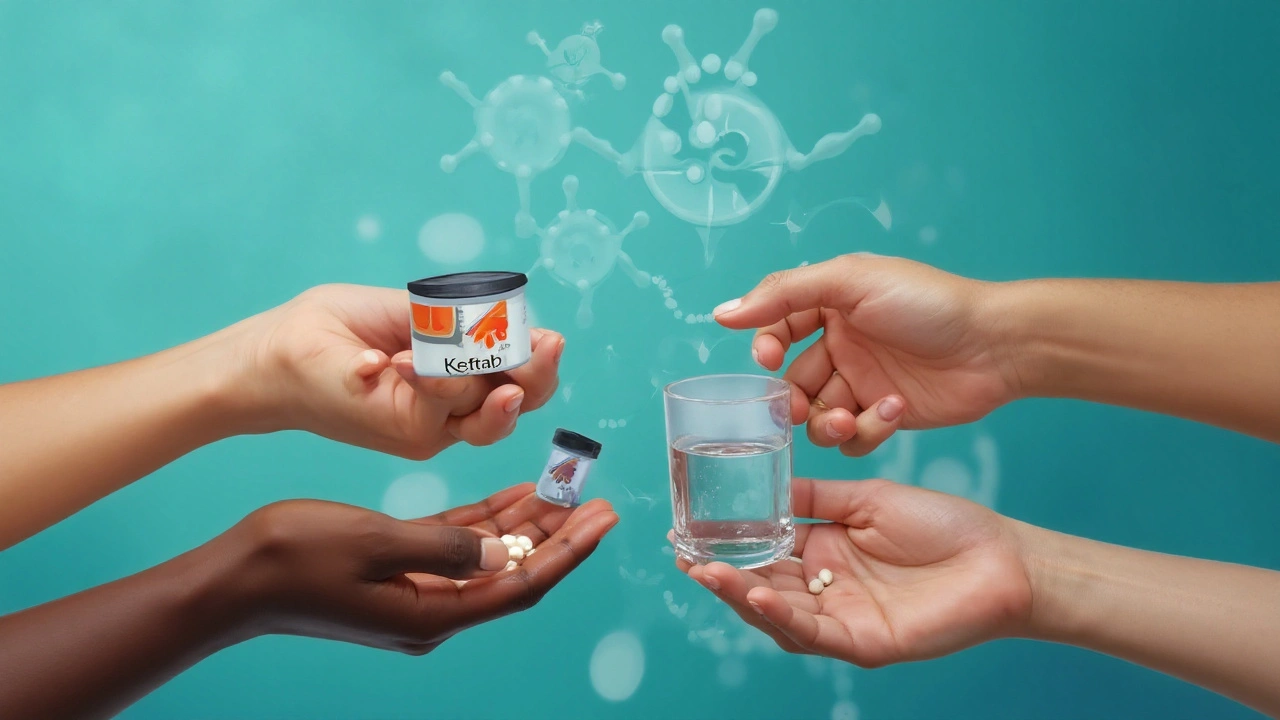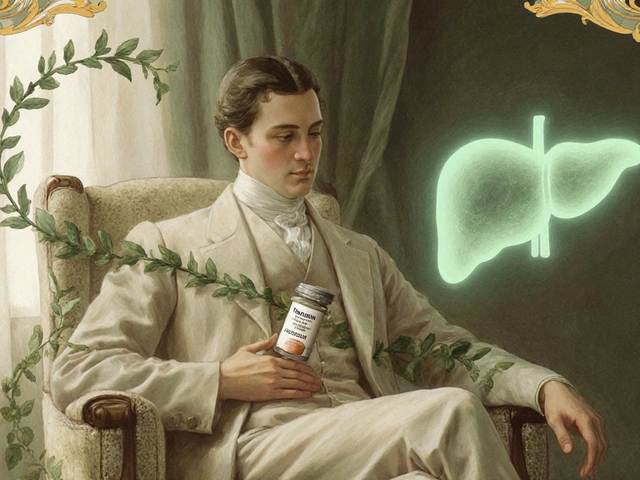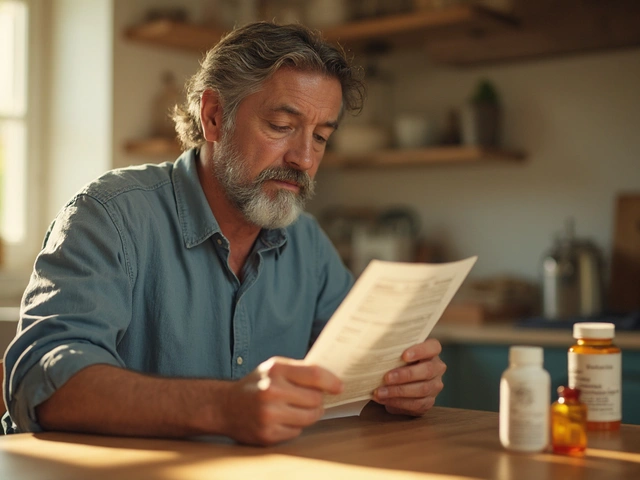When a scratchy throat turns into something nasty, or your child suddenly develops a painful earache, one name occasionally pops up on the prescription — Keftab. Not exactly a household word unless you’ve already tangled with an infection, but in doctor’s offices across the UK and elsewhere, this medicine has been quietly doing its job for decades. It’s not glamorous, but it’s reliable. What’s hiding behind that strange name, and what should you expect if you’re taking it? Spoiler: there’s more to know than the pharmacy leaflet lets on.
What Exactly Is Keftab and How Does It Work?
Keftab is just the brand name for a medicine called cephalexin, which lives in a family of drugs called cephalosporins. It’s an antibiotic, so its number one mission is fighting off infections caused by bacteria. Not viruses — sorry, your cold or flu will not surrender to Keftab, and taking it “just in case” does more harm than good. It works by messing with the cell walls of bacteria. Imagine the bacteria’s protective shell springing leaks, leaving them exposed and pretty helpless. No wall, no bacteria — your body does the rest.
Keftab has been around since the late 1960s. The folks who first made cephalexin were racing against the rise of penicillin resistance. Keftab became the go-to (especially for people allergic to penicillin) because it’s good at handling common culprits like strep throat, skin infections, stuffy sinus infections, tonsillitis, and what doctors call “uncomplicated urinary tract infections” (which, frankly, are never as simple as that sounds when you have one).
You might hear doctors refer to Keftab as a “first-generation” cephalosporin. What’s that mean? Basically, it’s the oldest branch of the cephalosporin family tree, so it works best on certain “simple” bacteria, not the trickier hospital-dwelling types. So if you’re dealing with a routine infection in the community, Keftab is probably on your doctor’s radar.
When and Why Is Keftab Prescribed?
This is where things get interesting. Not every bug will drop dead after a dose of Keftab. It’s great against stuff like Streptococcus (think throat and skin infections), Staphylococcus (“staph” infections, including the classic impetigo kids pick up at school), E. coli and Proteus mirabilis (the villains behind many UTIs), and some Klebsiella strains. If you’re allergic to penicillin, or your infection just doesn’t need something strong and fancy, Keftab is an old reliable.
Doctors usually prescribe it in capsule, tablet, or liquid form. Here’s a cool trick — the liquid tastes surprisingly decent for a medicine, so it’s not a battle of wills every mealtime with kids (or some adults). You’ll often see it prescribed twice a day, sometimes four times, depending on what you’re fighting and how bad it is. The course is usually five to fourteen days. Don’t stop early because you feel better; that’s the fastest way to have the germs regrouping before you know it.
Just a heads-up, though: not all infections are Keftab’s territory. Serious pneumonia? Hospital infections? Some sexually transmitted ones? Those need bigger guns. Similarly, if you keep getting the same infection over and over, don’t expect your GP to keep handing out Keftab. They’ll want to see what sneaky bacteria are hanging around and maybe switch tactics.

What Should You Watch Out For? Side Effects and Safety
Keftab is one of those rare medicines that’s both old and still popular, partly because its side effects list, while real, is usually manageable. The main problems most people run into? Nausea, a bit of stomach ache, or maybe loose stools. If you’re unlucky, you might notice yeast infections (thrush) pop up because, while Keftab targets “bad” bacteria, it can upset your normal “good” bacteria too. Unusual taste in the mouth and mild headaches show up for some but rarely stick around.
Allergies are the one big red flag. If you break out in a rash, start itching, or (yikes) start wheezing or notice your face swelling up, drop everything and seek help. It’s rare, but serious reactions — even full-blown anaphylaxis — have happened. According to a 2023 NHS study, less than 1% of Keftab users reported severe allergic reactions, but it’s still not something you want to ignore.
Here’s a pro tip: be honest with your doctor. If you’ve ever had a dodgy reaction to penicillins or other antibiotics, mention it upfront. Cephalosporins and penicillins are chemical cousins, so there’s a slim risk of cross-reaction. Your doctor might pick something else or give you a supervised test dose if you’re really stuck.
Something else to watch for — if you’ve got kidney disease, or are elderly, dosing might need adjusting. The kidneys handle most of the work clearing Keftab from your system. Throw in regular blood checks if you’re on it for ages or you’re juggling a few prescription meds.
How to Use Keftab Safely: Real-Life Tips
There’s more to getting antibiotics right than just picking up the prescription. With Keftab, here are a few tips that can make a real difference:
- Take it at regular times — try to space doses evenly. An alarm on your phone works wonders if you’re forgetful like me.
- Swallow the capsules or tablets with a glass of water. Skip the fancy drinks — especially ones with alcohol.
- If you’re using the liquid, give it a good shake and measure carefully with the included spoon or syringe. Eye-balling it doesn’t cut it, trust me.
- Don’t skip doses, and don’t stop when you feel better. Use the whole course unless your doctor tells you to stop. Half-finished antibiotics are how superbugs win.
- Watch for signs that things aren’t working — fever not budging, pain getting worse, new symptoms showing up. That’s your cue to ring your doctor again.
- Keep Keftab out of sight and reach of children. The liquid might taste sweet, but an accidental extra slug is not a good thing.
- If you’re pregnant or breastfeeding, Keftab is usually considered safe, but always ask your doctor anyway. Sometimes, weighing up the risk and benefit is a personal call.
- If you notice severe diarrhoea (especially with blood or mucus), stop the medicine and get checked out — it could be a rare but nasty infection called C. diff.
One cool thing — Keftab isn’t heavily affected by most foods, so you don’t need to time your meals just so. Just stick to the schedule, stay hydrated, and you’re on the right path.

Common Myths and Honest Answers About Keftab
Loads of confusing stories go around about antibiotics like Keftab. Let’s debunk a few:
- Keftab will treat your viral infection — Nope. If your doctor says, "You don't need antibiotics" for a cold, they're not being stingy; Keftab just won’t work on viruses.
- You’ll get “immune” if you use antibiotics too much — It’s not you who becomes immune, it’s the bacteria. That’s why doctors hesitate to dish out antibiotics like sweets.
- All cephalosporins are pretty much the same — They’re not. Keftab is a first-gen; later gen cousins are reserved for bigger, scarier bugs, especially in hospitals.
- You can drink alcohol safely with Keftab — For once, yes. Unlike some other antibiotics (like metronidazole), moderate alcohol isn’t banned, but being sick and drunk is never a great mix.
- Keftab fixes toothaches and abscesses instantly — Not always. Sometimes you need other dental treatment, and antibiotics alone won’t solve the underlying problem, just tamp it down for a bit.
If you’re prescribed Keftab more than once for the same problem, ask your doctor why and if it’s time for a different approach. Medicine shouldn't be a repeat loop.
Keep in mind the battle against antibiotic resistance started in part because early antibiotics like Keftab were so successful that we overused them. The golden rule: only use them when you genuinely need them, and always as prescribed.







Justin Atkins
August 13, 2025 AT 19:25Nice write-up — concise and useful. I appreciate how you separated mechanism, indications, and practical tips; that taxonomy helps clinicians and laypeople alike figure out when cephalexin (Keftab) is actually appropriate.
One quick addendum: renal dosing adjustments are more relevant than many sources admit, especially in older patients on multiple agents that compete for renal clearance. Also watch for drug interactions that change gut flora indirectly — proton pump inhibitors, for instance, can increase susceptibility to enteric infections when combined with broad antibiotic exposure.
All in all, good job balancing accessibility with clinical nuance.
Amreesh Tyagi
August 14, 2025 AT 02:06Not sure why every doc reaches for this as a first line tho
Seems like reflex prescribing. lots of infections are viral and yet it gets handed out. maybe docs are just playing it safe
Robert Jaskowiak
August 14, 2025 AT 03:06Playing it safe or playing it lazy? Big difference.
Sometimes a quick throat swab or a bit of patience avoids an unnecessary antibiotic. Other times you actually need to nip a strep in the bud before it's a full-blown mess. The problem is not the drug, it's the decision-making process. People want certainty and doctors want to avoid missed complications.
So yeah, reflex prescribing happens, but so does thoughtful prescribing. The trick is not to confuse the two.
June Wx
August 14, 2025 AT 21:33Ugh I literally hate when I get offered antibiotics for a cold.
Like, do they think I don't know the difference between a virus and bacteria? I pay attention to my body. If I wanted meds for everything I'd be a walking pharmacy cabinet.
Also the bit about the liquid tasting decent is EVERYTHING — my kid hates most meds but actually tolerates that one so well. huge relief.
Julia Gonchar
August 14, 2025 AT 22:33On the taste point: the pediatric formulation has flavoring agents, yes, but palatability can vary by supplier. If a liquid tastes off, pharmacists will sometimes compound it differently or swap brands.
kristina b
August 16, 2025 AT 01:20This article invites a cascade of reflections on the ethical, practical, and epistemological dimensions of antibiotic stewardship. First, to speak plainly, cephalexin represents an archetype of mid-20th-century pharmacological triumph: simple mechanism, robust efficacy against community pathogens, and a relatively benign safety profile compared to many modern agents. Yet that very success is part of the paradox that birthed antimicrobial resistance — we celebrated an accessible solution until its ubiquity eroded its own utility.
Second, there is a temporal moral hazard here. Clinicians who grew up in an era where antibiotics invariably ended infectious episodes may be less inclined to adopt watchful waiting. That cultural memory informs practice patterns in ways that guidelines alone struggle to dislodge. We must therefore attend to both cognitive habit and institutional incentives.
Third, from a patient perspective, the symbolism of 'an antibiotic prescription' is potent. It confers validation — the sense that one’s suffering is recognized and treated. This psychological affordance complicates stewardship: refusal to prescribe without adequate explanation can erode trust. Thus educational communication is not optional; it is an ethical necessity.
Fourth, the pharmacokinetics deserve more public airing. Renal clearance, tissue penetration, half-life, and the impact of obesity on volume of distribution are not trivial footnotes. Dosing intervals and duration should be individualized when possible, especially for elderly and polymedicated patients.
Fifth, the article’s practical tips are excellent but could stress follow-up more emphatically. A five-day course with a planned reassessment at 48–72 hours when symptoms persist reduces both overuse and harm.
Sixth, the anecdotal reassurance about alcohol is useful, but nuance is again key: moderate alcohol may not have a direct pharmacodynamic interaction with cephalexin, yet alcohol can impair immune responses and hinder recovery from infection.
Seventh, there is the larger societal frame: antibiotic policy is not merely clinical guidance; it is a public good problem. Individual prescriptions contribute cumulatively to resistance patterns that future patients will inherit. We should therefore embed antibiotic decisions within a stewardship ethic that privileges collective well-being alongside individual care.
Finally, while Keftab remains a vital tool, the medical community must continually refine its approach: better diagnostics, clearer communication strategies, and system-level incentives that reward appropriate restraint rather than reflexive intervention. Without these, even well-intentioned guidance risks becoming another leaflet on a dusty shelf.
In sum, this piece lays out the essentials admirably. My plea is only that readers remember antibiotics are not mere commodities but shared resources whose value depends on judicious stewardship and informed, compassionate practice.
Ida Sakina
August 16, 2025 AT 02:20Painful to read such complacency about overprescribing
It is our duty to refuse casual antibiotic use
We must protect future generations from our present convenience
Caitlin Downing
August 16, 2025 AT 03:20Totally agree with the stewardship point but also curious: how often do you all see penicillin-cephalosporin cross-reactivity in practice?
I once had a patient report an "allergy" to amoxicillin years ago and they insisted it was life threatening. We did a proper allergy history and it read like someone had a rash as a kid. Switched them to cephalexin with caution and no issues, but I wonder if anyone else has a standard approach — test dose, skin testing, or just avoid entirely?
Brianna Valido
August 17, 2025 AT 05:06Love this topic 😃
Little reminder: if you’re ever unsure, ask the pharmacist — they can often suggest alternatives or dosing tweaks. Also, finishing the whole course is so important — even if you feel better halfway through.
Sending good vibes for speedy recoveries to anyone dealing with an infection ❤️
Annie Crumbaugh
August 17, 2025 AT 06:06Thanks, that actually cleared things up.
Justin Atkins
August 18, 2025 AT 08:53On cross-reactivity: literature suggests true cross-reactivity is lower than historically thought. The allergenic determinant in penicillin differs from cephalosporins, and first-generation cephalosporins like cephalexin carry a small risk, mostly when the initial reaction was immediate and severe. A detailed history is paramount. If the prior reaction was a benign rash decades ago, many clinicians will proceed with caution rather than absolute avoidance.
When in doubt, skin testing for penicillin followed by an observed dose can be reasonable in select cases. That said, resource availability and patient risk factors will shape the practical approach.
Julia Gonchar
August 18, 2025 AT 09:53Brief note: in outpatient clinics where skin testing is impractical, a graded oral challenge after careful history is a pragmatic alternative. It’s not perfect, but it balances safety with the need to avoid unnecessarily broad-spectrum antibiotics.
Robert Jaskowiak
September 11, 2025 AT 16:13I’m with the folks pushing for better diagnostics. Point-of-care tests that reliably distinguish bacterial vs viral infections would change everything. Until then, we keep guessing and sometimes overprescribing.
Also fwiw if someone’s getting recurrent UTIs on cephalexin maybe they need imaging or a culture rather than repeated empiric courses. Empiric therapy is fine once or twice, but repeating it without investigating is just band-aiding the problem.
Ida Sakina
September 12, 2025 AT 19:25Indeed we must invest in diagnostics and public education
Antibiotics are not mere conveniences
They are scarce resources entrusted to our care